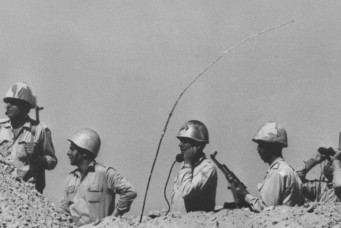The 1973 War and its Aftermath: The View from Damascus
Syrian gains in the conflict were elusive as a unilateral strategic move from the Egyptians put them in jeopardy

Israeli troops run for shelter under Syrian artillery fire in the Golan Heights. October 1973. Magnum Photos
Fifty years ago, Egypt and Syria launched a joint attack against Israeli forces, triggering the fourth Arab-Israeli war. Unlike its predecessors, the 1973 October War, also known as the Ramadan War or the Yom Kippur War, was the first time that Arab armies jointly launched an otherwise unprovoked attack against Israeli forces, giving themselves unprecedented strategic advantage.
The joint attack was well-coordinated and meticulously planned, and, unlike previous wars, Arab officers were more proficient, and the infantry better trained and well-equipped. Historically, Moscow had provided its Arab clients second-class military equipment for fear that they would go to war against Israel and draw the Soviet Union in a conflict with the United States. Moreover, fellow Arab states displayed an unprecedented level of solidarity, some by assisting symbolically in combat operations, and others by imposing an oil embargo on states supporting Israel.
Paradoxically, although the 1973 October War was exceptional in terms of Arab preparation and Arab solidarity, its aftermath was fiercely divisive. In fact, the polarization in which the Middle East currently finds itself can be traced back to it. This essay provides a brief narrative of the October War fifty years ago, as viewed in Damascus, and highlights the major events it triggered, both regionally and internationally. While a plethora of literature exists on the war itself, few analysts have considered how it shaped the next five decades.
The 1967 June War Sets the Stage
The 1973 October War cannot be understood without reference to the 1967 Six-Day War. On June 5, 1967, Israel launched a blitzkrieg against Egypt, Jordan, and Syria. In the first few hours of the war, Israel destroyed their respective air forces. In the Sinai, with little if any Egyptian air cover to speak of, Israeli forces crushed the Egyptian army and took over the entire peninsula. That operation lasted two days. In the following two days, Israel defeated the Jordanian army and occupied the West Bank of the Jordan River—the remaining 22 percent of what was left of Palestine, administered by Jordan since 1949. In the final two days of the war, between June 9 and 11, Israel occupied Syria’s Golan Heights, almost without a fight.
The Golan Heights, a mountainous region overlooking Lake Tiberias and the Hula Valley, had long been a source of friction between Syria and Israel. Israeli settlers would repeatedly encroach on territories in the demilitarized zones, drawing Syrian fire. Israel would later justify its assault of the Golan by claiming that Syrian gunners above would shell Israel below. This narrative is disputed even by Israel’s then-defense minister, Moshe Dayan, who was later quoted in a 1997 article in the Agence France-Presse as saying: “Israel could be blamed for over 80 percent of the incidents which enflamed tensions around the demilitarized zones between Israel and Syria ahead of the 1967 War.”
In order to provoke incidents with Syrian troops and change the ceasefire lines between the two countries, the Israelis “would send a tractor into a disputed zone to plow even when we knew the land was unplowable, in expectation that the Syrians would open fire on them, which they did.” Dayan goes further by admitting “I made a mistake in allowing the conquest of the Golan Heights in 1967. As defense minister I should have stopped it because the Syrians were not threatening us at the time.”
It is the Golan’s abundant water resources that Israel coveted, not security as Israel claims. The source of the Jordan River is in the Golan. Israel’s attempts to divert Jordan river water and channel it through its “National Water Carrier”—a system of giant pipes, open canals, tunnels, reservoirs, and large-scale pumping stations—to the Negev Desert and Syrian efforts to counter it laid the ground for the June 1967 War.
The October War did not take place in a vacuum. The joint Egyptian-Syrian decision to resort to force was the product of Israel’s failure to withdraw from the territories it had occupied in the Six-Day War, as per United Nations Security Council Resolution 242. It was also a product of the diplomatic stalemate that followed the 1967 War—a stalemate facilitated by superpower inaction.
United Nations special envoy Gunnar Jarring’s six-year effort to settle the conflict (along with other diplomatic initiatives) was unsuccessful. Anwar Sadat, who became Egypt’s president in 1970, was cooperative, offering among other things to reopen the Suez Canal. The canal was closed to international shipping since June 1967. Diplomacy failed in large part due to Israel’s intransigence. Buoyed by U.S. military and financial support, especially following Richard Nixon’s U.S. presidential election in 1972, Israel dug in its heels.
In the meantime, Syria’s leader Hafez Al-Assad quietly observed Sadat’s diplomatic overtures, knowing full well that diplomacy without teeth would go nowhere. In Al-Assad’s mind, Arab territories could be reclaimed through diplomacy only if backed by power.
Assad and Sadat had additional reasons for resorting to force. For Al-Assad, recovering the Golan Heights was perhaps his highest priority following his takeover of power in November 1970. As defense minister in 1967, Al-Assad was partly responsible for Syria’s defeat. Moreover, it was he who broadcasted “Proclamation 64” during the Six-Day War. The proclamation asserted, prematurely, that Qunaytra, the capital of the Golan, had fallen to Israeli forces when, in reality, it had not. The idea—a bad one as it turns out—was to prompt the UN Security Council to impose a ceasefire before Israeli forces advanced further into Syrian territory. Little did the Syrian leadership know that the U.S. representative to the UN, Arthur Goldberg, would intentionally delay Security Council proceedings through excruciatingly long speeches to allow Israeli forces time to complete their conquest of the Golan—even after the June 10 ceasefire went into effect.
The fallout from “Proclamation 64” was disastrous: Syrian troops stationed along the front heard it on Damascus radio and withdrew in utter chaos. It also had a shocking effect on Syria’s citizenry. How can the Golan front, with its seemingly impregnable Maginot Line-like defenses, fall in only two days? A local conspiracy theory spread like wildfire. According to that theory, Al-Assad, a member of the Alawite minority in a Sunni majority country, was supposedly complicit in Syria’s defeat. Therefore, for Al-Assad, recovering the Golan, by hook or by crook, would become his central security and foreign policy challenge throughout his presidential tenure.
For Sadat, Egypt’s war-shattered economy weighed heavily. His predecessor, Gamal Abdel Nasser, had carried out the costly 1969 War of Attrition, a tit-for-tat static war consisting of Egyptian artillery shelling of Israel’s frontline positions followed by devastating Israeli air strikes against Egyptian infrastructure and cities. Egypt could no longer sustain the war economy that the status-quo dictated. This led to Sadat’s decision to use force to break the stalemate.
Sadat proclaimed 1971 to be “the year of decision”. His declaration was only half a bluff. Al-Assad and Sadat began planning the two-front strategy in early 1971. By the end of that year, the two leaders appointed General Mohamed Sadiq, Egypt’s defense minister, as supreme commander of both armies and reached an agreement on a broad strategy. They devoted much of 1972 and 1973 to filling their arsenals with Soviet military equipment, implementing deception campaigns, and training their troops in countless rehearsals for D-day.
The Canal and the Golan
On October 6, 1973, at 14:00, Egypt and Syria launched their joint attack. Some four thousand Egyptian guns and 250 aircraft pounded Israeli forces along the Bar-Lev Line—a defensive line named after the pre-war Israeli chief of staff, Haim Bar-Lev. The Bar-Lev Line was a chain of fortifications built by Israel along the eastern bank of the Suez Canal after it occupied the Sinai Peninsula from Egypt during the 1967 War. It came in response to Egyptian artillery bombardments during the 1969 War of Attrition. Israel developed the fortifications into an elaborate defense system spanning 150 kilometers along the Suez Canal. The Bar-Lev Line was designed to defend against any major Egyptian assault across the canal and was expected to function as a graveyard for Egyptian troops.
That the Egyptian forces seized the Bar-Lev Line in two hours is testimony to the meticulous planning behind their assault. Hundreds of rubber dinghies ferried waves of infantry across the Suez Canal, overran the thirty-five forts of the Bar-Lev Line, and quickly established a forward perimeter. High velocity water jets blasted some eighty passages through the sixty-foot-high sand barrier piled up along the eastern bank of the canal.
At exactly the same time on the Syrian front, a massive three-pronged armored thrust of three infantry divisions, the fifth, the seventh, and the ninth, stormed the 1967 ceasefire line along the Golan front. The first and third divisions had been held back in reserve to take advantage of any breakthrough. Simultaneously, helicopter-borne commandos, later joined by Moroccan commandos, seized the Mount Hermon observation post in hand-to-hand combat, depriving the Israelis of gunnery spotting. The advancing divisions made uneven progress: in the north and center of the Golan where Israeli defenses were stiffer, the seventh and ninth divisions made only modest gains, at a high cost in troops and equipment, as they crossed the Israeli anti-tank ditch. The ditch was four meters deep and four to six meters wide along the sixty-five-kilometer front, flanked by a high earth embankment and protected by minefields on all sides. In the south, however, General Ali Aslan’s fifth division broke through Israeli defenses and drove its defenders from much of southern and central Golan. The hurried arrival of Israeli tank reservists prevented a total collapse on the morning of October 7.
When Al-Assad and his army chief of staff Youssef Chakour saw the progress of the fifth division, they ordered the first armored division to slice through the center of the front and attack Israel’s key Golan command post at Nafak. On the night of October 7, two Syrian thrusts by the fifth division and the first armored division were within striking distance of Lake Tiberias, otherwise known as the Sea of Galilee. One more push and Syria would recapture the Golan.
There was great elation throughout the Arab World. Images of jubilant Egyptian troops crossing the Suez Canal spread rapidly. In Damascus, people stood on rooftops to watch Israeli air force pilots parachuting from their burning Phantom F-4 fighters, downed by Syrian SAM-6 surface-to-air missiles and by MIG-21 interceptors. Cheers could be heard throughout the city as Syrian television broadcast footage of Syrian tanks punching through Israeli defenses, and of beleaguered Israeli troops taken prisoner. The June 1967 humiliation suffered by Egyptian and Syrian forces at the hands of Israel was temporarily erased from public mind. This was a moment of great national pride and an unprecedented spirit of national unity. The legitimacy of both Sadat and Al-Assad was at its peak.
The Egyptian Letdown
Just as Syrian forces were on the brink of liberating the Golan, the Egyptian high command ordered an operational pause between October 7 and 14. Having successfully crossed the Bar-Lev Line, Egypt’s armies sat in their defensive positions, making no attempt to race for the key Mitla and Giddi passes that control the only east-west route across the peninsula. The pause was not meant to consolidate gains or to absorb an Israeli counter-offensive, as one might expect. It was the product of Sadat’s secret strategy: to shake the superpowers out of their lethargy in the hope that they would resolve the conflict diplomatically. His decision to pause was backed by senior military officers: the Egyptian high command did not want Egyptian forces to advance beyond the area covered by Egypt’s surface-to-air missile network so as to protect their ground forces from Israel’s superior air force.
The problem is that this was not the plan Sadat shared with Al-Assad when the two leaders decided in early 1971 to launch their joint attack. The plan they had agreed on was to recover the territories Israel occupied in 1967. As it turns out, Sadat had two plans: a fictitious one he shared with Al-Assad, and another plan—a secret one—that he shared only with his senior military commanders. The Soviet leadership was as stunned at the Egyptian pause as Al-Assad was outraged. In short, Sadat misled Al-Assad.
During the pause, the U.S. Air Force Military Airlift Command conducted a massive airlift to Israel between October and November of 1973. Code-named “Nickel Grass,” the airlift included 22,325 tons of tanks, artillery, ammunition, and supplies shipped in C-141 Starlifter and C-5 Galaxy transport aircraft. The airlift saved Israel from certain defeat.

Photos
The Egyptian Pause and its Consequences
As a result of the Egyptian pause, which the Israeli high command detected early on, Israel shifted its focus to the Syrian front as the Syrian advance in the Golan represented an imminent threat to Israel. Whereas the Sinai is an open and distant desert, far from Israel proper, the Golan then included newly established Jewish settlements (illegal under international law) and was merely a few miles from the old Syria-Israel 1949 armistice line. Given the stakes, Israel deployed the bulk of its reserves along the Syrian front.
The counterattack began on October 11. The Israeli air force now focused on Syria, started bombing economic targets, such as the Homs refinery, and urban centers, including Damascus, to disperse Syria’s highly effective SAM-6 surface-to-air missiles. Whereas the Israeli air force then flew fifty sorties a day against Egyptian forces, it flew a thousand a day against Syrian forces.
The result of the Egyptian pause and the subsequent Israeli counter-offensive against the Syrian front was that Israeli forces were able to stop the advance of Syrian forces and to roll them back, reaching the town of Saasaa, only twenty-four miles away from Damascus. The Israeli thrust into Syrian territory beyond the 1967 ceasefire line was halted in part by Iraqi artillery. It was only following Saudi Arabia’s refusal to end its oil embargo—unless the United States pressured Israel into withdrawing from the new pocket that its forces now occupied—that U.S. secretary of state Henry Kissinger negotiated a disengagement agreement between Syria and Israel that turned Israeli forces back to the pre-October 6 line.
As a result of the intense pressure that Al-Assad applied, Sadat took the political decision—against the advice of his senior military commanders—to resume operations in the Sinai. At this stage, Sadat could not afford to sour relations with his wartime ally. He ordered Egyptian forces to advance on October 14. That decision was a military disaster. On the night of October 15-16, Israeli forces were able to separate the Second and Third Egyptian armies, enabling them to break through the canal. At Deversoir, north of the Great Bitter Lake, the Israelis established a bridgehead and crossed into Africa. They penetrated the interior of Egypt and surrounded the Third Egyptian army. Egypt appealed for assistance and the Soviet Union seemed ready to respond. On October 25, Washington placed its armed forces around the world on nuclear alert.
In sum, the pause harmed Egypt as well. Failure to follow up on Egypt’s initial successes enabled Israel to absorb the massive inflow of American equipment described above. It also enabled Israeli strategists to pinpoint weaknesses in Egypt’s frontline positions.
The Consequences of Egypt’s Defection
For Syria, the Egyptian pause was a colossal setback, and this was only the beginning in a slippery slope that would take Egypt out of the Arab-Israeli conflict. Following several Kissinger-brokered disengagement of forces agreements between Egypt and Israel, Sadat authorized secret talks with Israeli officials in Morocco, journeyed to Israel, addressed the Knesset in Jerusalem, held more talks at Camp David, and signed a separate peace treaty with Israel in March 1979. The peace agreement was made in violation of Arab League resolutions that prohibit Arab states from pursuing this option. In brief, Sadat’s Egypt defected from the Arab camp.
In Western eyes, the Egyptian leader was a man of vision and a man of peace. He won the Nobel Peace Prize along with Israeli Prime Minister Menachem Begin. In Syrian and Arab eyes, Sadat was believed to be a “traitor”. Egypt’s membership in the Arab League was suspended for ten years, and the headquarters of the Arab League was moved from Cairo to Tunis.
Egypt’s defection from the Arab camp tilted the Arab-Israeli balance of power heavily in Israel’s favor. With Egypt’s strategic weight largely absent, Israel was free to pursue its illegal settlement activity in the Golan Heights and in the West Bank, annex the Golan in 1981, bomb the Iraqi nuclear reactor that same year, and invade Lebanon in 1982—free from the threat of any significant retribution. The challenge for Syria to contain Israel within its 1967 boundaries, the reason for which it went to war in the first place, became greater than ever before.
Syria Shifts Alliances: Egypt Out, Iran In
Although there is no direct relationship between Egypt’s defection from the Arab camp in March 1979 and the Islamic revolution in Iran in February of the same year, Egypt’s defection triggered a major regional shift. It brought about a strategic alliance between Syria and the Islamic Republic of Iran. To date, this alliance is the most enduring strategic alliance in the Middle East.
Iran under the Shah was, along with Israel, a major pillar of U.S. power in the region, and Iran and Israel had been like-minded in their hostility towards the Arab World. In contrast, the new regime in Tehran brought down the Pahlavi dynasty, tore the CENTO treaty with the United States, expelled the Israeli embassy and its staff from Tehran, turned the Israeli embassy over to the PLO, and called for the liberation of Jerusalem, occupied by Israel in the June 1967 War.
It should then come as no surprise that Al-Assad, being the balance-of-power man that he was, would embrace the Islamic revolution. For Al-Assad, the Islamic revolution was a godsend; Iran would become the substitute to Egypt as a counterweight to Israel. Parenthetically, that the Islamic Republic condemned the Syrian branch of the Muslim Brotherhood—at the time in the throes of war against the secular Al-Assad regime—was, for Al-Assad, the icing on the cake.
In light of this, Al-Assad seized the opportunity that the Islamic revolution provided to strengthen Syria’s hand against Israel. Al-Assad opened Syria’s gates to the Pasdaran—a branch of Islamic Revolutionary Guard Corps—to train Lebanese Shiite recruits who were the main victims in the Israel-PLO slugfest of the late 1970s in the south of Lebanon. This led to the emergence of Hezbollah, a powerful Iran-sponsored Shiite militia and a sworn enemy of Israel, and the establishment of the Iran-Syria-Hezbollah alliance: the “Axis of Resistance.”
In conjunction with the alliance with Iran, Al-Assad sought to reach strategic parity with Israel. Strategic parity did not necessarily mean tank-for-tank and plane-for-plane, but rather a balance of power that deters Israel from further expansion and provides teeth to the Arab negotiating position.
In the end, Al-Assad’s policy of strategic parity proved to be elusive. Although Syria was able to re-arm during the 1980s to the point of becoming a potential challenge to Israeli power, the policy was doomed with the advent of Soviet Communist Party Secretary General Mikhail Gorbachev. Gorbachev’s policy of reducing tensions in U.S.-Soviet relations had a stultifying effect on Syria’s security policy: the Soviet Union would no longer back Syria in its effort at establishing strategic parity.
Al-Assad’s relationship with Iran fared better, even though it put Syria temporarily at odds with Saudi Arabia and the Gulf states, especially during the Iran-Iraq War. Whereas Al-Assad viewed Israel as the biggest threat to the Arab World, Saudi Arabia and the Gulf states viewed the theocracy in Iran as an even greater threat to their security—especially given that the Iranian leadership was openly seeking to export its revolution.
The Net Results of October 1973
The October 1973 War has rightly gone down in history as a landmark in the annals of warfare. Militarily, the initial gains of the joint Arab forces were admirable, whether it be the engineering behind the Egyptian crossing of the Suez Canal or the Syrian breakthrough in the Golan. These achievements were evidence that Israel was not invincible. In fact, had it not been for the massive U.S. airlift, Israel would have faced a major defeat.
The October War also showed that Israel is not necessarily safe by expanding its territory at the expense of others. To the contrary, territorial expansion through force breeds further conflict. In this instance, had Israel not attacked its neighbors in June 1967, the 1973 War might not have broken out.
That said, Israel was able to reverse the situation thanks to massive U.S. support, including putting out a nuclear alert. This shows the extent to which Washington will go to assist its junior ally. The initial Arab military achievements and the concomitant threat to Israel led Washington to increase its assistance to an even higher level: arm Israel to the teeth so as to maintain superiority over any combination of Arab power.
Politically, the October war achieved Sadat’s goal, as it got the attention of the superpowers—the United States in particular. The result of Egypt’s statism was an Egyptian-Israeli peace treaty in which Egypt recovered its sovereignty over its territory. However, Sadat’s success in recovering the Sinai back was due not to Israeli benevolence but to a conscious Israeli move to snatch Egypt, the strongest Arab power, out of the Arab-Israeli conflict.
Egypt’s statism, however, did nothing for the rest of the Middle East in general and for Syria and the Palestinians living under Israeli occupation in particular. Nor did the Middle East peace process of the 1990s for that matter. In fact, Egypt’s defection produced the opposite. It led to an even more violent Middle East in which Israel’s attempts to impose its rules were countered by an emerging “Axis of Resistance”—more threatening to Israel than the Syrian-Egyptian alliance ever was.
Murhaf Jouejati is Distinguished Visiting Professor in Global and Middle East Studies at the United States Naval Academy. Prior to that, Dr. Jouejati taught International Relations and Middle East studies at the Emirates Diplomatic Academy in Abu Dhabi (2015-2020); the National Defense University’s NESA Center (2005-2015); The George Washington University (2000-2015), and the American University in Washington (2003-2005). He is the author of, among others, The Making of Syria’s Strategic Culture, and has published numerous journal articles on security issues in the Middle East. On Twitter: @mjouejati.
Read More



